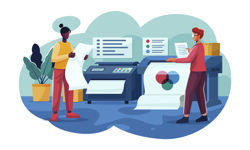A tiny chip is set to replace a fistful of coins and notes for many everyday low-value payment transactions. Demand for the latest generation of contactless payment solutions is likely to be driven by consumers and retailers. Industry commentators, technology companies and banks have been talking up the possibility of universally accepted ‘e-purse’ systems for small transactions for almost two decades now. So far the reality has never lived up to the hype.
Advances in smartcard technology, and falling unit costs, means that the technical barriers have all but disappeared. Customers are much more attuned to the idea that a tiny chip incorporated on a card, or within another everyday device, such as a phone, could be used to store money; allowing them to pay for a daily paper, a cup of coffee, a bus fare, a lunch or a pint of milk, without having to carry around a pocket full of coins.
Early systems, such as Proton in Belgium, relied on contact technology, where the card had to be physically swiped across a reader to pay for goods, or to be topped up with cash. The new generation of smart cards utilise contactless technology; users simply tap and go.
The potential benefits are significant for many types of organization, ranging from conventional financial services providers to retailers, transport, telecoms, utilities, sports stadia and local councils, to name just a few.
Where do people spend real money?
Deloitte research indicates that not only are 63% of all cash transactions less than £5, but around half of all ‘micro-payments’ (transactions of less that £15 in value) are accounted for by just eight categories of spending. In London, for example, the top three categories, accounting for 25% of micro-payments are:
* Top-up groceries
* Spending at CTN outlets
* Payments in pubs and bars
It’s realistic to expect that many of these transactions will be for magazine and newspaper purchases.
Why is Oyster successful?
The best example of successful adoption of contactless pre-pay in the UK is TfL’s Oyster card. Around 10 million cashless transactions are carried out every day. It heralds a new more potent threat to cash, and one which should get newspaper circulation managers excited about the opportunities it presents them.
It deals with low value transactions, doing away with the need for cash, and shows that people are prepared to pre-pay. Differential pricing has been used to encourage people to use Oyster card, as has its ease of use (you don’t even need to take it out of wallet or handbag for it to work). It is also secure, allowing people to get their money back on a lost card.
How does this relate to newspapers?
Newspaper purchases represent similar low value transactions, allowing pre-payment, where speed and convenience is of a premium (NB contactless cards allow a transaction to be completed in 2-4 seconds, compared to a credit/debit card transaction of 16 seconds). One of the reasons that Metro has been so successful, and the piles in bins at transport hubs disappear with startling speed, is that you don’t have to wait in line to pay. WHSmith has noticed this trend, and has installed ‘trust’ payment bins at some of its railway shops.
The Sell – how contactless smartcards can benefit newspaper publishers
We have noted ten key ways that newspaper publishers can exploit this new technology and the ensuing business models, should a critical mass of retailers adopt a smartcard approach to payments:
1. Reduced cash management costs throughout the supply chain
Handling cash costs money. By minimising its use, you can have lower security costs and better banking rates through a reduction of risk of non-payments and cash shrinkage, ie retail staff with sticky fingers!
2. Improved demand planning
Through reading data on the card when it is used, you can begin to build a picture of who regularly buys your newspaper from which outlets. This can help you plan supplies more accurately, and hence reduce wastage and the costs that that entails.
3. Greater information on readers’ purchasing habits allows for better targeting of promotions
If card holders register their cards, you are able to track where and when they buy your newspaper, and possibly what else they buy at the same time. This information provides a great basis for targeting promotions at them, for example if they are irregular purchasers. If you know there is significant crossover between your newspaper and another publication, you can exploit that commercially.
4. Increased sale through speed of service
Contactless cards mean that there is no longer a need to scrabble for coins, to wait for the retailer to get the correct change for you, or to process your card. This means shorter queues, and hence a greater prevalence for customers to purchase when they are in a hurry.
5. Pre-payment gives interest and cash-flow benefits, and also benefits from lost or unused cards
Similar to subscription schemes, pre-payment on cards means you benefit from the sale before you have handed the product over. There is also significant benefit from unclaimed cash on cards when lost (but crucially, usually at a small level, meaning it is not often a disincentive for the customer to take the card in the first place).
6. Reduced administrative costs for operating subscription schemes (for publisher, wholesaler and retailer)
There is no longer a need for the despatch of paper coupons and reminder letters for subscribers. Once they have received a card, they can top up over the internet. Similarly, wholesalers and retailers no longer need to handle time-consuming coupons, since all records can be passed electronically.
7. Introduction of small vending machines
With pre-paid cards, vending machines no longer need to have an in-built safe to hold cash. They also no longer need to be emptied by security guards and the cash banked. The safes in vending machines are one of the main contributors to their unwieldy size. Without the safes, small vending machines can be placed in convenient transport hubs etc.
8. Ability to adopt dynamic pricing to reduce returns
Since the cards and readers are electronic, circulation managers can come up with a variety of creative pricing mechanisms. For example, why not sell copies of the morning paper after 5pm for just over cost price, to increase ABCs and reduce returns?
9. Pre-payment enables lower value transactions through the internet
Readers will be able to access individual articles, or whole areas of your website, for a lower price, rather than being driven away by expensive subscriptions for all content.
10. Selling access to your service and administrative infrastructure to other publishers
Once you have built your network of adoptive retailers, and have developed the data capture infrastructure, you can capitalise on this investment by charging other publishers, on a per-transaction basis, for using your system.
Issues to address
However exciting some of these opportunities might sound (with the potential both to increase sales and to reduce costs), there is still a great deal of effort required to develop the details of the business case for a contactless payment solution for newspapers and magazines.
There are a variety of common issues that are often raised by publishers when such opportunities are outlined, but there are already solutions to many of these issues:
* Technical standards - ‘let’s not get stuck with the equivalent of Betamax’
Visa and Mastercard are collaborating on a common technical protocol to reduce the need for this. Gathering the correct network of partners, and gaining critical mass with retailers, should minimise this risk.
* Security
This depends on the investment you want to make on individual cards, and how much data you wish them to carry and transmit. However, even to ‘hack into’ the cheapest of these types of cards, you would have to break a sixteen digit password. The value of the money held on this card would not make this type of illegal enterprise worthwhile!
* Retailer take-up, in the light of the Chip & Pin introduction, and competition for counter space
Often it’s quite hard to see your friendly local retailer behind his or her bank of lottery machines, cash registers, PayPoints, chip and pin readers etc. The introduction of another such piece of hardware could well drive them over the edge! This is where your choice of partner is important, so the retailer feels it is worth his or her while accommodating you (especially if you can adopt standards that use hardware he or she already holds).
* Ability to explain dynamic discounts on a timely enough basis for reader and retailer
This could be solved by the creative use of e-mailing, texting and RFID (Radio Frequency Identification) technology. When the customer enters their CTN, they could receive a text message telling them that your newspaper is on special offer that day.
* Introduction of vending machines and / or downward pressure on payments to wholesaler and retailer will bring conflict
You will need to see the wholesalers and retailers (especially the latter) as partners in this initiative, since you are dependent on them for it to work. Also, you must maintain good relationships with these players to enable you to continue to service those customers who are not willing to adopt your card. You should be prudent in how you share the benefits from this system across the supply chain!
In conclusion
With payment systems, especially contactless ones, moving towards maturity, they are able to provide consumers with a cheap, secure and quick alternative to cash for low value transactions. These benefits should drive customer take-up, and create critical mass to attract retailers and various goods producers.
Newspaper publishers should take advantage of this opportunity, since they have been identified, through research, as one of the key groups that can benefit from consumers wishing to use cash alternatives to purchase their goods. They can test the water by replacing their admin-heavy subscription coupon schemes with cards, or they can dive into the brave new world, driving sale through speed of usage and alternative outlets (eg vending machines) or gathering useful customer data through this two way interaction.
To ensure they don’t fall down pitfalls that pioneers typically fall foul of, they need to choose the correct partners (possibly including fellow publishers), and the correct technology to build critical mass of retailers accepting of the new technology. Most importantly, they should understand their strategy for driving sales and gathering customer data.
All this, and less pockets will be ruined with redundant metal discs!
FEATURE
Just tap and go!
Star columnists, DVD give aways, glossy supplements, Sudoku. What is your strategy for building sales, or at least slowing their decline. Could it be that a large part of the answer lies in smartcard technology? Deloitte’s Peter Simon and William Yarker present the case.










